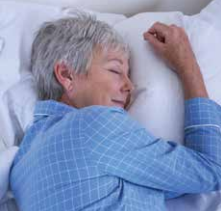
Having good sleep is critically important to remaining healthy. We recognize that prolonged sleep deprivation has a negative effect on the cardiovascular system, diabetes, hypertension and depression. Some of the benefits of getting a good sleep are that during certain phases of sleep, our body removes some of the toxic metabolic waste that accumulates in our brain and causes neurological diseases such as dementia and Parkinson’s disease. Good sleep enables concentration during the day, improves memory, supports immunity and regulates emotions.

One of the experiences that interrupts good sleep is neck and shoulder pain. The position of our heads in a forward position puts us at risk of that. “Text neck” or holding the head forward for long periods of time happens as a result of work situations. Seventy-five per cent of workers sit to work of which 90 per cent are software developers, and 80 per cent are accountants etc. This results in neck pain, trigger points at the back of your head, headaches, restricted neck movements and impairment of movement of your neck and thorax. As we age, the forward head posture leads to upper neck extension to compensate, less flexion of the lower neck which leads to forward bending of your thoracic spine and rounded shoulders. We spend a third of our time sleeping, so maintaining a good position at night is essential.
There are many studies but they are small and the science is difficult to do. In a study of 800 people, they found that 72 per cent were side sleepers. That is fortunate, since this is the most protective position to prevent cervical pain. Another study from Australia found in the 812 people, that 46 per cent woke at least once a week with symptoms. Twenty-seven per cent had scapular or arm pain. Nineteen per cent had headaches, 18 per cent cervical pain and 17 per cent cervical stiffness. In another study, 82 per cent woke with headaches 1-2 per week. Seventy per cent had stiffness, 64 per cent cervical pain, 52 per cent scapular or arm pain. Unfortunately, 52 per cent found these symptoms persisted for at least half a day. There are differences related to age and gender. Women 40-59 years of age had cervical pain and stiffness, headache and arm pain. Women over 60 had cervical stiffness. Men 40-59 years of age had more symptoms, especially those doing manual labour. They also were at the greatest risk of waking with a headache. As we age, both men and women have fewer headaches. Men over 60 had the greatest scapular and arm pain. Perhaps the stiffness as we age is related to the fact that the number of shifts of position at night decrease.
Basically we need to find the perfect pillow that maintains horizontal cervical position, not head forward position, encouraging symmetrical relaxation of bilateral muscles along the spine. Apparently, this is challenging to do! We do know that if the pillow is too high the cervical spine bends forward and the peak contact pressure shifts to the hip area. If the pillow is too low, your neck bends backwards. As I mentioned, the studies assessing the type of pillows are small and contradicting. Body dimensions, you would think could be used to calculate how high the pillow should be but this is not reliable. As time goes on, they have become more sophisticated in their assessments measuring position of head, muscle tension, pressure sensitivities but still no concrete answer. I think the general agreement is that feather pillows are the least helpful. Using foam, rubber and polyurethane do seem to work best with the height of pillow between 7-11 centimetres. Orthopaedic pillows that are u shaped to support the neck area without pushing your head up work best. The pillow needs to be firm enough not to compress to the point it doesn’t support. Interestingly, pillows with a cooling surface are helpful to maintain sleep. Not surprisingly, the company that makes the smart phone is developing a pillow that automatically assesses the spine alignment, body dimensions, contact pressure and muscle activity and adjusts to accommodate. That will be a great addition to solving this problem!
To summarize:
1. Be aware of your head forward position and actively try to improve that. Perhaps spend less time on your computer or phone. Think of tucking the angle of your jaw up and back.
2. Assess your sleeping position and avoid the head forward position.
3. Look for a supportive rubber foam pillow, U shaped, 7-11 cm in height.
Dr. Vicki Holmes is a Saskatoon retired family physician who has a special interest in Palliative Care and Women’s Health. She is passionate about sharing medical information with the public! (Vicki’s Photo: Memories by Mandy)
– Dr Vicki Holmes

Leave a Reply